Certainly since the 1870s and the rise of Impressionism, art movements have come and gone with incredible speed. It is interesting to see how quickly the Jugendstil (German art nouveau) color woodcuts, that make such an interesting western comment on the Japanese woodcut tradition, become overwhelmed by the new Expressionist mode - a jagged, rough-edged, almost brutal aesthetic, which nevertheless proves able to accommodate motifs as traditional as deer grazing in a landscape. All of the images in this post are taken from issues of the Viennese art revue Die Graphischen Künste. The first comes from 1910, and is I think an exceptional example of a Jugendstil woodcut. It's an incredibly strong yet subtle image, and for once I think my photograph does it justice.
 Heine Rath (German, 1873-1920), EisblumenWoodcut, 1910
Heine Rath (German, 1873-1920), EisblumenWoodcut, 1910Leap across the First World War, and what do we find? A completely new world. The images are black-and-white, stark and uncompromising. Some of the artists are politically engaged, some are not, but in every case there is a rejection of decorative appeal in favour of graphic strength. I won't try to comment on each one, but simply let the images roll. It's interesting to see how the same aesthetic can be applied to the cityscape, landscape, animals, people, with such powerful results. But just as this movement took its momentum from the continental fracture of the Great War, it received its death blow from the rise of the Nazis. Faced with such horrendous ideas and actions - and the suppression of dissident artists - Expressionism had neither the vocabulary nor the means to survive.
 Erwin Lang (Austrian, 1886-1962)Turm von St. Stephan in WienWoodcut, 1932
Erwin Lang (Austrian, 1886-1962)Turm von St. Stephan in WienWoodcut, 1932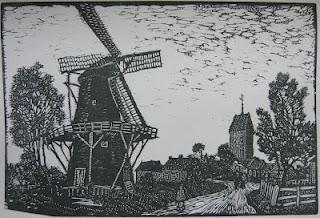 Emma Bormann (1887-1974)Aus Hollande (Godlinze)Woodcut, 1922
Emma Bormann (1887-1974)Aus Hollande (Godlinze)Woodcut, 1922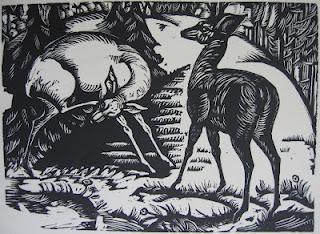 Adolf Weber-Scheld (German, 1892-?)ReheWoodcut, 1931
Adolf Weber-Scheld (German, 1892-?)ReheWoodcut, 1931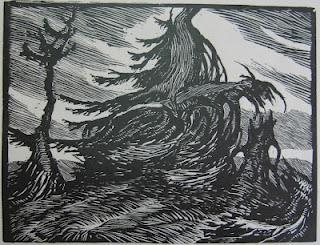 Ernst Hrabal (Czech, 1886-1969)PietàWoodcut, 1925
Ernst Hrabal (Czech, 1886-1969)PietàWoodcut, 1925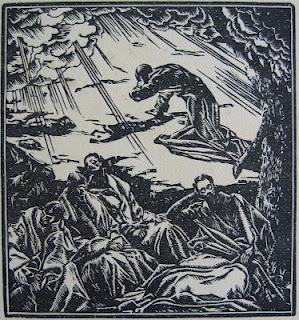 Elfriede Miller-Hauenfels (Austrian, 1893-1962)Christus auf dem ÖlbergWoodcut, 1922
Elfriede Miller-Hauenfels (Austrian, 1893-1962)Christus auf dem ÖlbergWoodcut, 1922I am particularly interested in the religious connotations in the two cuts above, and the one below. In a way one thinks of Expressionism as a post-religious movement of the Machine Age. But the woodcut by Hrabal shows how even the landscape could evoke religious feeling, while that of Miller-Hauenfels reimagines the torment of Christ on the Mount of Olives in twentieth-century terms. As for what is happening in the image below by Walter Clemens Schmidt - who knows?
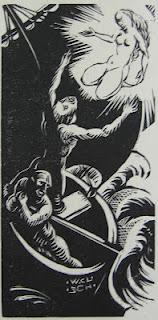 Walter Clemens Schmidt (German, 1890-1979)GlückschiffWoodcut, 1925
Walter Clemens Schmidt (German, 1890-1979)GlückschiffWoodcut, 1925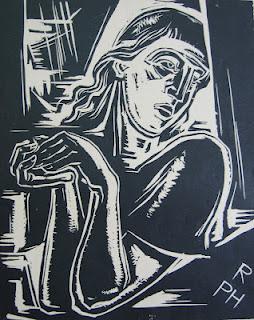 Robert Philippi (Austrian, 1877-1959)Törichte JungfrauWoodcut, 1930
Robert Philippi (Austrian, 1877-1959)Törichte JungfrauWoodcut, 1930Robert Philippi, the creator of this foolish virgin, taught Egon Schiele wood engraving and etching.
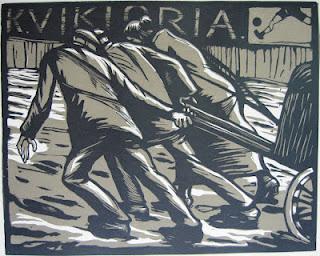 Jan Rambousek (Czech, 1896-1976)KarrenzieherWoodcut, 1933
Jan Rambousek (Czech, 1896-1976)KarrenzieherWoodcut, 1933Note the billboard advert for the Prague football club FK Viktoria in the background.
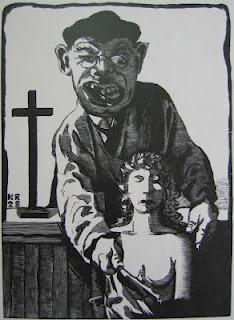 Karl Rössing (Austrian, 1897-1987)Einwandfrei ProzessführungWoodcut, 1928
Karl Rössing (Austrian, 1897-1987)Einwandfrei ProzessführungWoodcut, 1928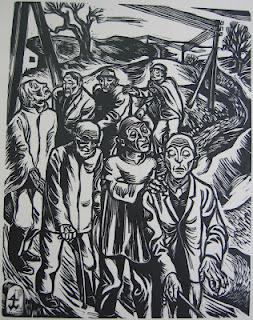 Johannes Wohlfarht (Austrian, 1900-1975)BlindenzugWoodcut, 1933
Johannes Wohlfarht (Austrian, 1900-1975)BlindenzugWoodcut, 1933The tone of Expressionist art - always satirical and sarcastic - became more bitter by the year, as fascist ideas first appeared then blossomed then overtook sane society. This woodcut by Johannes Wohlfarht (or Wohlfart, sources vary).Titled Procession of the blind (or, perhaps, The blind leading the blind), it is a mordant political satire for the year 1933, which saw the Nazis rise to power in Germany. Johannes Wohlfahrt was greatly influenced by the anarchist Herbert Müller-Guttenbrunn. Before the rise of the Nazis Johannes Wohlfahrt's art was mostly concerned with the plight of the downtrodden and exploited; after, he sought refuge in religion, and most of his work after 1930 is religious in nature, albeit still often with a satirical point to make.

